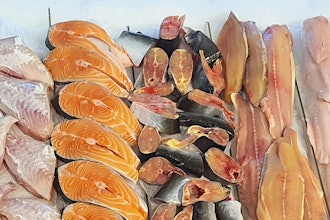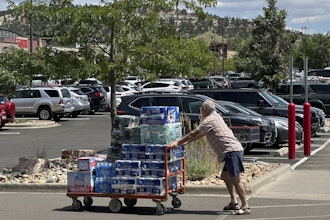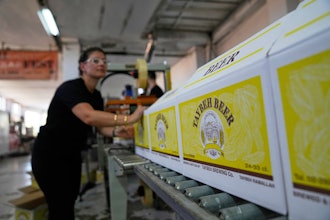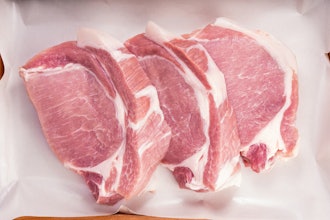
As of 2022, there are 1.9 million farms across America’s rural landscape. 95% are operated by families. Yet, only around 6% of those farms market foods to locals through direct-to-consumer sales. The rest travel distances, some much farther than others. Last year, $174.9 billion of American agricultural products were exported to the rest of the world.
Forty percent of the food grown and produced in America is never eaten. And 25% of what we buy to eat gets thrown away.
The gulf between Americans and the farms that produce their food has never been wider.
It’s not just about where produce is grown, but also when. For the most part, most produce has a growing season in which it’s at its highest quality. Apples, for example, are best when picked during autumn, while fresh corn is a summer vegetable that may lose some of its sweetness when grown in the winter.
It can be a tiring game of trying to find the best of a fruit or vegetable, especially since seasonal produce is sold well beyond its season, creating a difficult relationship with consumers. Big-name grocery stores don’t pull bushels of strawberries just because they were sourced outside of spring, so it’s up to the buyer to be well-informed of when produce is in season and, just as importantly, whether it is being sourced locally to make it easier to track its seasonal growth.
America Has It All
Many U.S. citizens live close to where their food originates, especially those in more agrarian or rural settings. Latitude and longitude define how bountiful the growing seasons can be, and thankfully, the U.S. has every biome from the Arctic to the tropics.
This makes seasonal consumption easy for most, as they’re more likely to be able to find seasonal produce when it’s at its best. But first, they have to make the effort.
Food influence watchdog Ricardo charted food trends in 2023, including those involving local produce, sustainability, and brand transparency. Understanding what will be available in the coming season where one lives aids in sourcing fresher, more flavorful produce.
Unfortunately, sticking to seasonal fruits or vegetables is hard for states that aren’t abundant with local growers or don’t have a suitable climate for seasonal growth. Desert environments, for example, can struggle to know when is best to shop for in-season produce when they basically skip essential growing seasons like spring and autumn.
Where and What to Plant
In general, growing food is an option for those with the land. The World Population Review gives times of the year for the USDA’s 11 planting hardiness zones. Alaska sits in Zone 1, subtropical Florida and the Keys sit in Zone 11, and Hawaii is in fully tropical Zone 13. The simple formula most aspiring gardeners can follow is the higher the zone number, the longer the planting period.
Hawaii in Zone 13 has no freeze, whereas some parts of Alaska in Zone 1 can only grow food between May and August. There are solutions, however. While critics may dislike polytunnels for their environmental impact, wood or glass-made greenhouses can lengthen any growing year.
The Grower’s Challenge
The contiguous United States ranges from Zone 3 to Zone 11, and the summer months will yield many opportunities for most Americans to eat seasonal produce. Sadly, many fruits, such as strawberries, figs, watermelon, and apples, have a short season — finding ways to replace these in colder climes is difficult, forcing some shoppers to settle for flavorless or mushy fruits.
When out of season, frozen produce serves as a suitable and nutritious replacement. EatRight says frozen vegetables or fruit can sometimes retain more nutrients than fresh. This makes sense, considering that frozen products are flash-frozen shortly after being picked, retaining the same level as freshly picked options.
However, many food lovers would argue that frozen produce cannot compete with fresh produce in flavor.
For those able to grow their own, summer leading into autumn is a bountiful time. The Farm Project promotes a year-long seasonal diet based on the varying U.S. region’s staples. In Maine, the May harvest brings only asparagus, greens, herbs, potatoes, and rhubarb. Meanwhile, sunny California is awash with choices like beets, lemons, and grapefruit, among many others.
Useful Resources
Anyone with spare land can grow produce, and there are resources to support them. Global Citizen reports how Big Green is helping growers disrupt an American food production system monopolized by large conglomerates that damage small-scale farming.
The organization funds projects throughout America, such as sending gardening materials, running learning workshops, and promoting food independence. Moreover, the campaign group has so far awarded almost $5.5 million in funding to schools and nonprofit groups across the United States.
Digital Farmers Markets & Urban Produce Revolution
Fresh produce is never far away, even in large cities, thanks to the digital farmers’ markets growing in popularity in the U.S. Food trends thinktank FoodTank says that online grocery sales spiked during the pandemic, though this returned to regular levels in the subsequent years. Nonetheless, while many have returned to the shopping aisles, interest in farmers’ market delivery services grows steadily.
Consumers, in general, want to support their local farmers with food-buying decisions, and dozens of farms have taken note. Online farm stores that deliver fresh and seasonal produce door-to-door locally are sure to become more abundant, building off the foundation laid by companies like Uber Eats and DoorDash.
These services can offer seasonal produce boxes at slightly elevated prices (for convenience) and include a glut of leafy greens, zucchini, mushrooms, and sweet potatoes for subscribers.
A No Brainer
Farm-to-fork is the end goal with produce, but it’s a more complicated concept when talking about seasonal produce. Out of season, consumers are left trying to find alternatives. During the season, finding specific produce can be difficult depending on the location and the local climate.
While they’re not a cure-all, online farm stores can help bridge the gap for some consumers, allowing them to potentially satisfy at least one aspect of their seasonal produce dilemma.






















